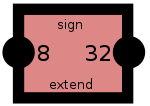(Created page with "right|200px right|150px Sign extension is an operation in which the number of bits representing a specific value i...") |
m (added wikilinks) |
||
| Line 1: | Line 1: | ||
[[File:Sign extender.svg|right|200px]] | [[File:Sign extender.svg|right|200px]] | ||
[[File:Sign extender square.svg|right|150px]] | [[File:Sign extender square.svg|right|150px]] | ||
| − | Sign extension is an operation in which the number of bits representing a specific value is increased while preserving the original sign and value. The exact method used to perform this operation depends on underlining signed number representation used on that machine. A '''Sign Extender''' or a '''Sign Extension Unit''' is a black box representation of such operation. The symbols on the right are usually used to represent such unit. | + | [[Sign extension]] is an operation in which the number of bits representing a specific value is increased while preserving the original sign and value. The exact method used to perform this operation depends on underlining signed number representation used on that machine. A '''Sign Extender''' or a '''Sign Extension Unit''' is a black box representation of such operation. The symbols on the right are usually used to represent such unit. |
== Two's complement sign extension == | == Two's complement sign extension == | ||
| − | In today's systems, the most common signed number representation is 2's complement. In two's complement, signed extension is done by simply repeating the most significant bit, the sign bit, into all the new bits we introduce. For example: | + | In today's systems, the most common signed number representation is [[two's complement|2's complement]]. In two's complement, signed extension is done by simply repeating the most significant bit, the sign bit, into all the new bits we introduce. For example: |
[[File:Sign extender 2s comp.svg|left]] | [[File:Sign extender 2s comp.svg|left]] | ||
| Line 29: | Line 29: | ||
{{clear}} | {{clear}} | ||
== Sign-magnitude sign extension == | == Sign-magnitude sign extension == | ||
| − | Similar to two's complement, in a sign-magnitude representation, the most-significant bit is also used to indicate the sign. Sign extension on sign-magnitude numbers works the same as two's complement. The MSB is repeated across all the new bits that were added. | + | Similar to two's complement, in a [[sign-magnitude representation]], the most-significant bit is also used to indicate the sign. Sign extension on sign-magnitude numbers works the same as two's complement. The MSB is repeated across all the new bits that were added. |
== C programming == | == C programming == | ||
In the sample [[C| code]] below. Assuming on this implementation <code>CHAR_BIT = 8</code> and <code>sizeof (int) = 4</code>. The assignment of c to i will | In the sample [[C| code]] below. Assuming on this implementation <code>CHAR_BIT = 8</code> and <code>sizeof (int) = 4</code>. The assignment of c to i will | ||
| − | undergo a sign extension - 24 extra bits will be added. In a two's complement sign representation those 24 bits will be identical to the 8th bit of c. | + | undergo a [[sign extension]] - 24 extra bits will be added. In a [[two's complement]] sign representation those 24 bits will be identical to the 8th bit of c. |
<source lang="C"> | <source lang="C"> | ||
char c; | char c; | ||
Revision as of 00:49, 31 December 2013
Sign extension is an operation in which the number of bits representing a specific value is increased while preserving the original sign and value. The exact method used to perform this operation depends on underlining signed number representation used on that machine. A Sign Extender or a Sign Extension Unit is a black box representation of such operation. The symbols on the right are usually used to represent such unit.
Two's complement sign extension
In today's systems, the most common signed number representation is 2's complement. In two's complement, signed extension is done by simply repeating the most significant bit, the sign bit, into all the new bits we introduce. For example:
| 8 to 32 bit extension | |||
|---|---|---|---|
| Input | Output | ||
| Base 10 | Base 2 | Base 10 | Base 2 |
| 4 | 00000100 | 4 | 00000000000000000000000000000100 |
| -4 | 11111100 | -4 | 11111111111111111111111111111100 |
| 42 | 00101010 | 42 | 00000000000000000000000000101010 |
| -42 | 11010110 | -42 | 11111111111111111111111111010110 |
| -126 | 10000010 | -126 | 11111111111111111111111110000010 |
| X | MNNNNNNN | X | MMMMMMMMMMMMMMMMMMMMMMMMMNNNNNNN |
Sign-magnitude sign extension
Similar to two's complement, in a sign-magnitude representation, the most-significant bit is also used to indicate the sign. Sign extension on sign-magnitude numbers works the same as two's complement. The MSB is repeated across all the new bits that were added.
C programming
In the sample code below. Assuming on this implementation CHAR_BIT = 8 and sizeof (int) = 4. The assignment of c to i will
undergo a sign extension - 24 extra bits will be added. In a two's complement sign representation those 24 bits will be identical to the 8th bit of c.
char c;
int i;
c = -42;
i = c;


